How to Implement a Workplace Wellness Program (Step-by-Step Guide)
Last Updated Sep 17, 2025

Employee burnout, rising healthcare costs, and constant turnover are eating into productivity — and your budget. Traditional wellness efforts, like step challenges or annual screenings, barely scratch the surface.
When employees feel stressed, unsupported, or disconnected, it’s not just their wellbeing that suffers. Engagement drops. Absenteeism climbs. Recruiting top talent gets hard, and keeping them becomes even harder. Without a strategic approach, “wellness” risks becoming an empty buzzword instead of a performance driver.
A comprehensive workplace wellness program changes all of that. By addressing physical, mental, financial, and social health together, you create an environment where employees feel valued as people, not just workers. The result? Measurable boosts in morale, retention, and ROI — along with a healthier, more energized workforce.
Uncover the benefits of building a wellness program that works for your people and for your bottom line.
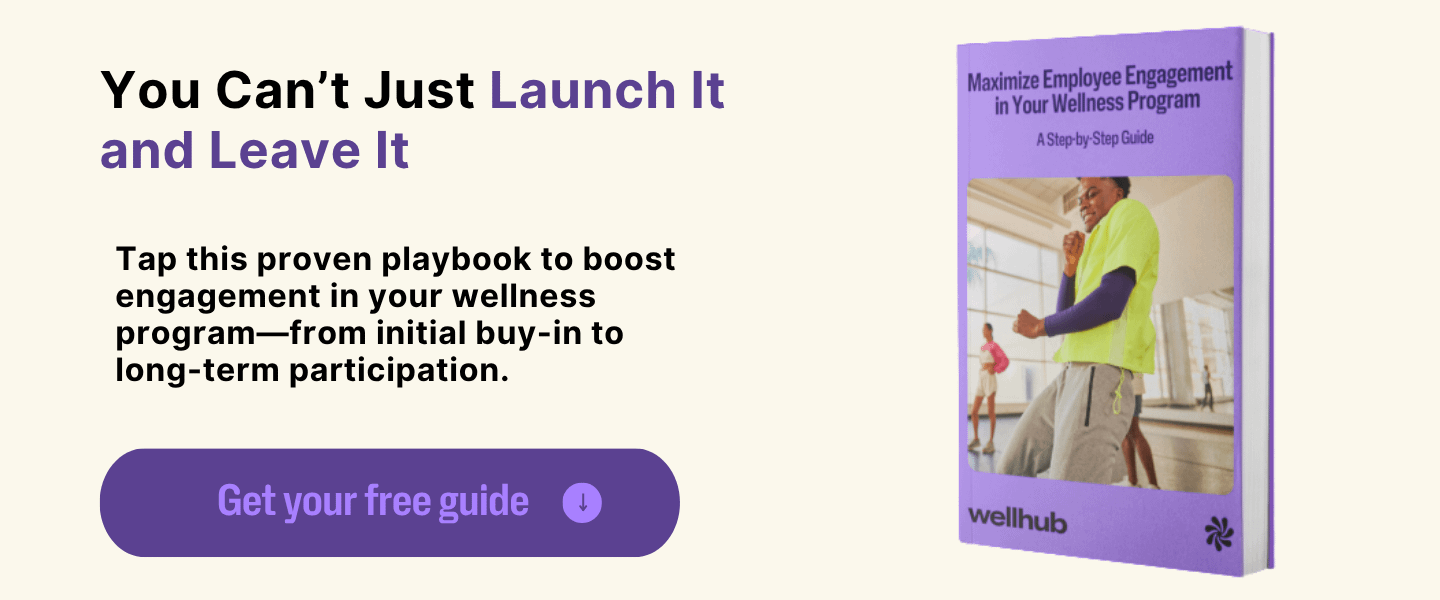
What You’ll Learn:
- Why Wellness Programs Matter: The definition of a modern workplace wellness program and the strategic benefits it offers – from higher engagement and morale to lower absenteeism, turnover, and healthcare costs.
- Key Wellbeing Pillars: The four core pillars of employee wellness (physical, mental, financial, social) with concrete examples of initiatives for each.
- How to Build Your Program (Step-by-Step): A 7-step blueprint for creating and rolling out a successful wellness program, including assessing employee needs, securing leadership buy-in, and driving participation.
- Overcoming Challenges: Proven strategies to tackle common hurdles like low participation, limited budget, and employee skepticism – so your program gains traction and delivers results.
- Tying It All Together with Wellhub: How a holistic approach (and the right partner, like Wellhub) can supercharge your wellness program and align employee wellbeing with your business goals.
What Is a Workplace Wellness Program?
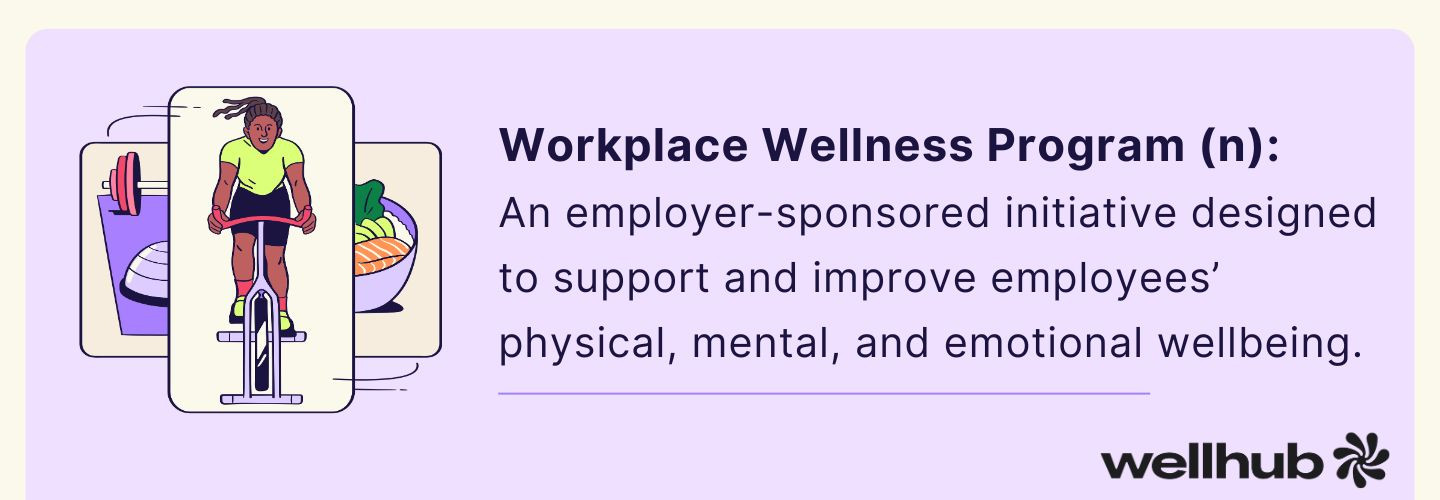
A workplace wellness program is an employer-sponsored initiative designed to support and improve employees’ physical, mental, and emotional wellbeing.
Traditional programs of the past often focused only on physical health (think step competitions or annual biometric screenings). But today’s top HR leaders know that true wellness is holistic. That means addressing the whole person: their physical, mental, emotional, financial, and even social health.
For example, instead of just counting steps, a holistic wellness program might also offer meditation classes for stress, financial planning workshops, and volunteer team outings to build social connections.
Dive deep into how workplace wellness can make your organization more successful.
How Wellness Programs Make Companies More Competitive (U.S. Stats in 2025)
Why invest time and resources in wellness? Because a well-implemented wellness program can fundamentally strengthen your company’s performance.
Here are four strategic areas where a wellness program can make a major impact:
Engagement & Morale
Healthy, supported employees bring their A-game. Wellness programs lift morale, energize teams, and keep people engaged. In fact, 89% of HR leaders who track wellness say engagement improved after launching their program. High engagement means employees are focused, passionate, and willing to go the extra mile.
The connection to job satisfaction is just as clear. Sixty-seven percent of employees at companies with wellness programs like their jobs more — and are just as likely to recommend their employer. That’s loyalty in action. When people feel their company invests in their wellbeing, they return the favor with commitment and positivity.
Reduced Absenteeism
Wellness programs keep people healthier, which means fewer sick days and less “presenteeism” (being at work but not fully functioning). Eighty-nine percent of HR leaders say sick days dropped after they implemented a wellness program.
Meta-analyses show effective wellness efforts can cut absenteeism by 25 to 30%. That’s more consistent productivity, fewer disruptions, and lower costs from temp coverage or overtime.
Wellness also prevents small issues from turning into long-term leaves. Fitness, nutrition, and mental wellbeing support help reduce chronic illness and stress-related absences — keeping people present, productive, and thriving.
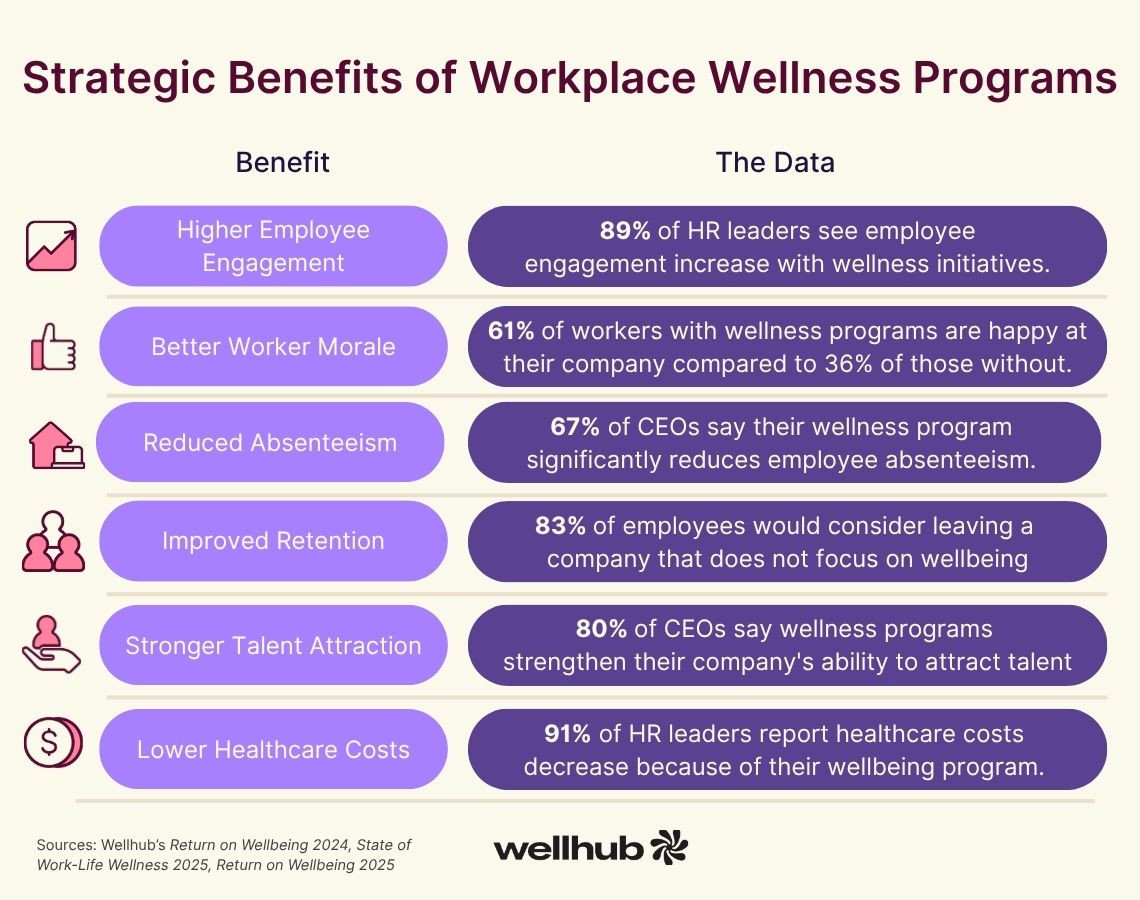
Talent Retention & Recruitment
Salary isn’t the only thing top talent weighs. A strong wellness program can be the deciding factor in attracting — and keeping — the best. In fact, CEOs report that wellness programs significantly strengthen their ability to attract talent as nearly nine in 10 workers factor in wellness benefits when choosing an employer. Especially for younger generations, wellness benefits are often seen as essential, not extra – over half of Gen Z and millennials say a company’s wellness program is important or extremely important to them when job hunting.
Retention gets a big lift too. Ninety-eight percent of HR leaders say wellness programs reduce turnover. Nearly half of employees at small to mid-sized companies say wellness benefits would make them stay longer. That’s loyalty you can measure.
From gym access to flexible schedules, showcasing wellness benefits tells candidates you value people, not just profits. This message strengthens your employer brand and helps win the war for talent.
Lower Healthcare Costs
Wellness programs save money — plain and simple. In Wellhub’s Return on Wellbeing 2024 survey, 91% of HR leaders said their healthcare costs dropped after introducing wellness initiatives. Healthier employees file fewer claims and use less insurance, cutting premiums and out-of-pocket costs.
External research backs it up: 72% of companies see lower healthcare costs after adding wellness programs. Harvard even found a 3:1 ROI, which means a $3 savings for every $1 spent. And the savings compound over time, thanks to fewer ER visits, better chronic condition management, and healthier lifestyles.
Wellness doesn’t just pay for itself — it funds better health, stronger teams, and a more resilient organization.
Here’s how to find a whole-person wellness program that boosts performance.
Key Pillars of a Comprehensive Employee Wellbeing Strategy
To design an effective wellness program, it helps to think in terms of key wellbeing pillars. A comprehensive strategy supports employees in multiple dimensions of wellness, recognizing that health isn’t one-dimensional. The four core pillars to consider are Physical, Mental, Financial, and Social wellbeing.
Let’s break down each, with examples of what you can include in your program.
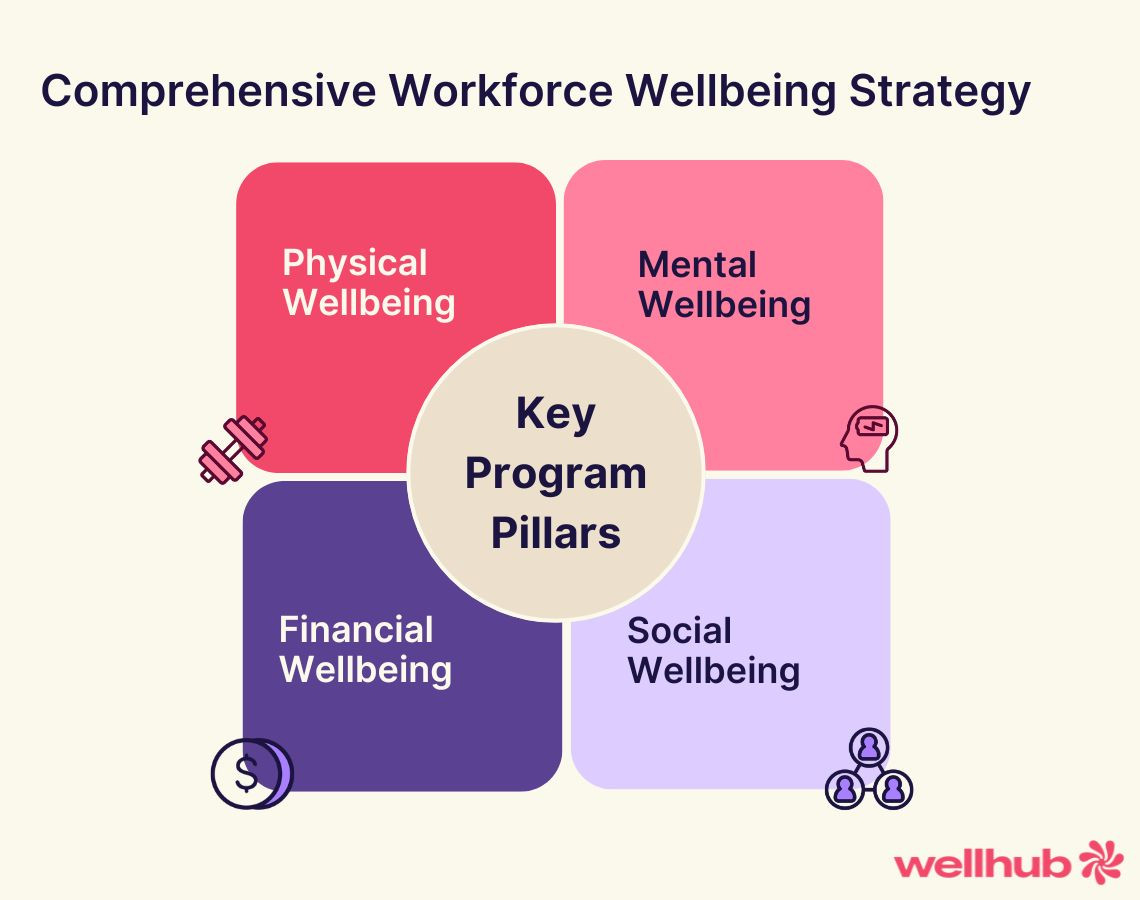
Physical Wellbeing
This is the classic wellness pillar for a reason. It’s all about keeping employees healthy through fitness, nutrition, and preventive care.
Why It Matters: Strong physical health reduces risks, cuts medical costs, and boosts energy. The CDC notes about 42% of U.S. adults are obese, raising risks for serious conditions. Programs that encourage fitness and nutrition can help reverse these trends. Healthier employees mean fewer sick days and lower healthcare claims — plus a more productive workforce.
Wellness Program Examples: Subsidize gym memberships or give access to workout apps. Get people moving with step challenges or walking meetings. Stock healthy snacks, set up ergonomic workstations, and run flu shot clinics or annual screenings.
Get employees moving:
- 30 workplace wellness activities
- 17 plug-and-play physical wellness ideas
- 5 actionable employee fitness challenge ideas
- The Ultimate Guide to Workplace Wellness Challenges for HR Leaders
Mental & Emotional Wellbeing
In today’s workplace, mental health support is non-negotiable. This pillar helps employees manage stress, build resilience, and find help when they need it.
Why It Matters: Eighty-one percent of workers say workplace stress has hurt their mental health. Left unchecked, that leads to burnout, depression, and turnover. The right support helps employees cope before problems escalate. Normalize mental health conversations, offer resources, and you’ll see less burnout, higher productivity, and a safer, more positive culture — all with significant cost savings.
Wellness Program Examples: Offer EAP counseling, stress management or mindfulness workshops, and paid mental health days. Provide meditation apps, quiet rooms, and train managers in empathy and realistic workload planning.
Strengthen workplace mental health:
- 7 proven strategies to strengthen emotional wellness at work
- Build psychological safety with these data-backed strategies
Financial Wellbeing
Money stress is a productivity killer. This pillar is about helping employees feel financially stable and confident.
Why It Matters: Nearly 48% of employees say financial worries are a top cause of poor wellbeing — up from 31% the year before. Financial security keeps employees focused, engaged, and less likely to job-hop. It’s especially valuable for younger workers managing debt and older employees preparing for retirement.
Wellness Program Examples: Provide financial counseling, workshops on budgeting and retirement planning, or access to finance tools. Offer student loan repayment help or negotiate employee discounts for financial services.
Social & Community Wellbeing
Humans are wired for connection. This pillar builds belonging, relationships, and purpose inside and outside of work.
Why It Matters: Strong social ties improve engagement and emotional health: 60% of workers say their productivity at work is lower when they feel lonely. Connection fuels teamwork, morale, and pride in your culture — especially important after pandemic-driven isolation.
Wellness Program Examples: Host team-building events, launch mentorship programs, and support Employee Resource Groups. Organize volunteer days and create casual spaces — physical or virtual — for non-work interaction.
Putting It All Together
An effective wellness strategy covers all four pillars, recognizing how they overlap. Struggles in one area often spill into others. Programs that go beyond “steps and salads” address real needs and pay off in higher engagement, productivity, and loyalty.
Keep top talent inspired with this professional growth blueprint. [20 ideas]
7 Essential Steps to Creating a Workplace Wellness Program
All right, HR superstars – it’s implementation time! We’ve covered the why and what of workplace wellness. Now let’s get practical with the how.
Here is a 7-step roadmap to guide you in building and launching your wellness program. Every organization is different, so feel free to tailor these steps to your company’s size, culture, and resources. The key is to hit each of these elements in a way that works for you. Let’s do this!
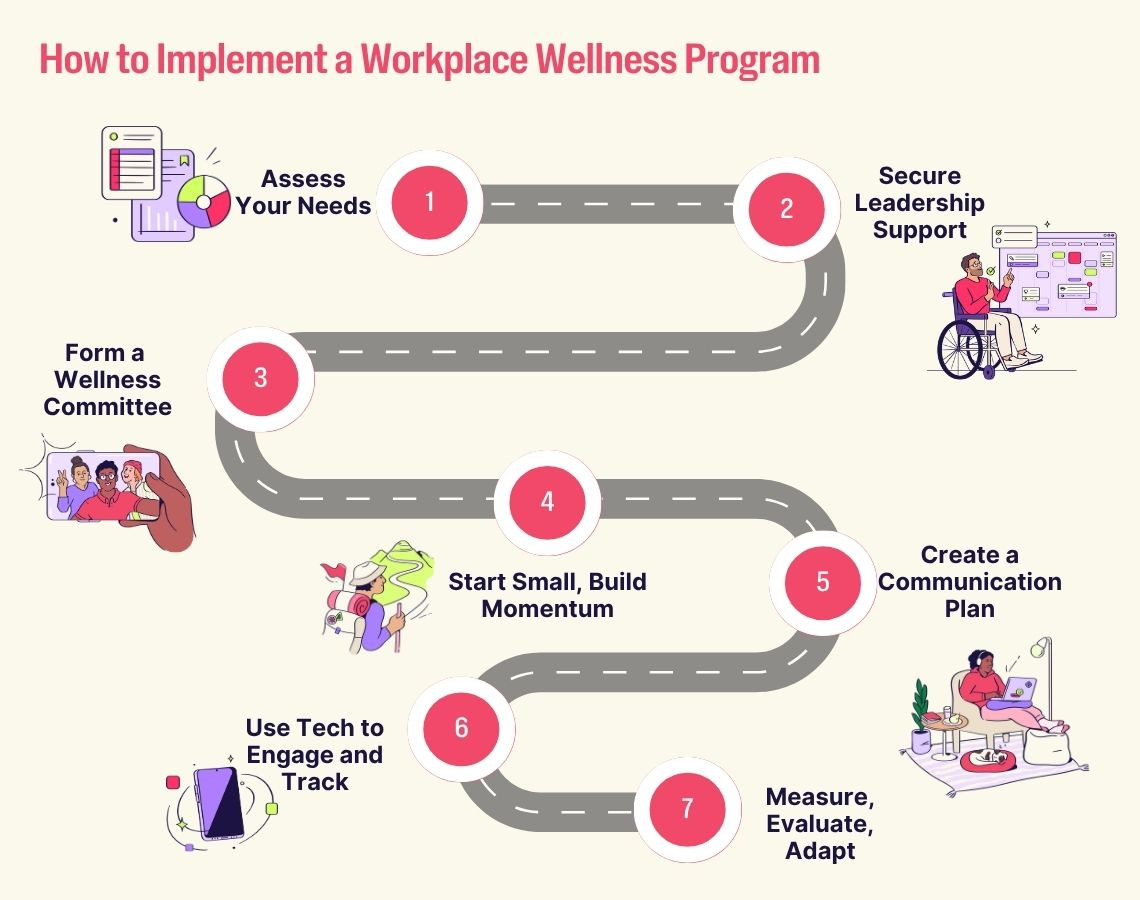
Step 1: Assess Employee Needs and Interests
Don’t guess — ask! Use surveys, focus groups, suggestion boxes, or one-on-ones to uncover employees’ top wellbeing challenges and what support they actually want.
Back it up with existing data — health claims, EAP usage, or absenteeism patterns — to spot trends. Involve employees from the start to make the program relevant and to build ownership before launch.
Step 2: Secure Leadership Buy-In
No buy-in, no budget, no cultural shift. Sell wellness as a business strategy, not a “nice-to-have.”
Lead with numbers: 95% of companies see positive ROI from wellness programs, with more than half earning $2+ for every $1 invested. Position wellness as a solution to leadership’s top concerns — retention, productivity, and cost control.
It also helps to remind leaders of the cost of doing nothing: employee burnout is currently costing companies hundreds of billions in lost output, and global disengagement is linked to an estimated $1.9 trillion in lost productivity. Drive home that if you invest in wellbeing, you’ll be paying for it in absenteeism, errors, healthcare claims, and constant recruiting to replace burnt-out staff.
Identify an executive champion to advocate for you, then keep leaders visible and involved. When the C-suite actively participates, it sets the tone for everyone – companies where leadership engagement in wellness is high see employee participation skyrocket from 44% to 80% on average. That visible support is priceless.
Step 3: Form a Wellness Committee
Wellness is a team sport. Recruit a cross-section of employees — different ages, roles, and locations — plus at least one leader as sponsor.
Give the group a clear purpose: generate ideas, coordinate activities, promote events, and provide honest feedback. It’s important to empower the committee members – they should feel ownership and have permission to be creative. Perhaps your Finance rep on the committee wants to lead a “Budgeting 101” workshop as part of financial wellness, or your tech-savvy member starts a "wellness" Slack channel for daily health tips. Great! This not only spreads out the work, it spreads the enthusiasm. When employees see their peers (not just HR) championing wellness, it creates a grassroots movement that can be incredibly effective.
Step 4: Start Small and Build Momentum
You don’t have to launch everything at once. In fact, starting with a few well-chosen initiatives builds excitement without overwhelming anyone.
Pick one or two quick wins based on employee interest — a step challenge, meditation app, or healthy lunch series. Early wins generate stories you can share, and success stories create demand for more.
Be sure to celebrate milestones and communicate results from these early efforts. For example, announce that “We had 60% of the company participate in our first wellness challenge – amazing!” or share a story of an employee who benefited. This kind of fanfare shows appreciation and reinforces that wellness is becoming part of your culture.
Layer in new offerings over time, checking feedback after each addition. Momentum is your friend — keep it rolling.
We made it easy: Launch your wellness program with this step-by-step guide.
Step 5: Create a Communication Plan
Even the best program will flop if no one knows about it. Treat communications like an internal marketing campaign.
Start strong — a CEO email, kickoff event, or wellness fair. Then, keep the drumbeat steady across multiple channels. What should you communicate? Continuously highlight:
- Upcoming activities or deadlines: (“Don’t forget – meditation workshop this Wednesday at noon, no experience needed!”)
- New resources or features: (“Great news – our wellness portal now has a financial wellness section with tools and webinars. Check it out!”)
- Success stories and shout-outs: This is big. People love to hear real examples. Share mini case studies: e.g., an employee who used the fitness benefit to train for their first 5K, or a team that started doing walking meetings and felt more energized. With their permission, tell those stories in newsletters or on the intranet. Also give shout-outs to departments with high participation or individuals who achieved personal milestones. Peer stories create relatability and inspire others (“If my coworker can do it, maybe I’ll give it a try!”).
Highlight upcoming activities, new resources, and — most importantly — employee success stories. Encourage managers to lead by example and make participation easy for their teams.
Step 6: Use Technology to Engage and Track
A central wellness platform or app keeps everything in one place — from sign-ups and schedules to leaderboards and progress tracking.
Consider using a wellness platform or app to be the digital hub of your program. This could be a platform provided by a vendor (like Wellhub’s app) or even an internal site you set up. The idea is to have a one-stop shop where employees can see all their wellness options, sign up for activities, track their progress, and maybe even earn points or badges. Many platforms integrate with fitness trackers, allowing employees to sync their steps or workouts – which opens the door to friendly competitions and leaderboards that make participation fun.
Tech can also automate important nudges: for example, push notifications or email reminders about upcoming events (“Yoga class at 5 pm today – click to join!”) can significantly boost turnout. Gamification elements (like challenges, points, and prizes displayed on the app) are proven to increase engagement by tapping into our natural enjoyment of games and recognition. Companies that use wellness apps and wearables often report higher participation – in fact, about 73% of organizations are now using wellness apps to support employees’ health.
Leverage the data to see what’s working, ensure privacy, and let the tech handle admin so you can focus on strategy and improvement.

Step 7: Measure, Evaluate, and Adapt
A wellness program is not a “set it and forget it” initiative. To truly succeed and justify ongoing investment, you need to measure results and continuously improve. Step 7 is about closing the loop: looking at what’s working (or not) and making adjustments so your program stays effective and relevant.
Define success metrics early. Decide how you’ll know if the program is making a difference. This likely includes both quantitative measures (hard numbers) and qualitative feedback (employee sentiments). Key metrics might be: participation rates (what percentage of employees use the programs and how frequently), health indicators (average steps per day, biometric screening improvements, etc., in aggregate), absenteeism (sick days taken), healthcare costs year-over-year, turnover rates, and employee engagement or satisfaction scores. For example, you might aim to see a reduction in average sick days per employee, or an improvement in engagement survey scores related to wellbeing support.
Also gather employee feedback regularly. Short pulse surveys or focus groups can reveal if people feel the program is valuable. Ask what they like best, what they don’t use, and what else they wish the program offered.
Once you have data coming in, make time (say, quarterly or biannually) to evaluate it. Look for patterns: Perhaps you discover that while 70% of employees registered for the new wellness portal, only 30% are active users – why might that be? (Maybe the interface is clunky or they forgot about it after sign-up, which is a communication opportunity.) Or you see that the on-site yoga class is mostly attended by people from one department – maybe other departments have schedule conflicts or different interests.
Use these insights to adapt the program. If a particular offering has low participation, don’t be afraid to pivot: maybe it needs to be better advertised, tweaked to be more appealing, or replaced with something else employees have asked for. Conversely, if something is wildly popular (say, the guided meditation sessions are always full), consider expanding it or using it as a model for other programs.
Share outcomes with leadership and employees to show momentum. For leadership, you might prepare a simple report: “Six months into the program, we’ve seen a 20% decrease in average sick days and a 5-point uptick in engagement scores. Healthcare claims costs are trending 8% lower than last year – indicating positive ROI. Here’s our plan to build on this success…”
Speaking the language of data will keep your executives enthusiastic, and your budget protected: CEOs who receive strategic updates on the impact of their wellness programs are significantly more likely to approve bigger budgets — 58% of those who receive monthly program updates increased wellness funding last year.
Launch a wellness program that lifts engagement and lowers costs.
Overcoming Common Challenges
Even with the best-laid plans, you might encounter some challenges or skepticism as you implement your wellness program. This is normal – but with the right strategies, you can overcome these hurdles and keep your program on track.
Let’s address three of the most common challenges head-on: (1) low participation, (2) budget constraints, and (3) lack of engagement or skepticism.
For each, we’ll cover the concern and how to respond effectively, so you’re prepared to handle objections like the solutions-focused leader you are.
Challenge 1: “What if our employees don’t participate?”
The Concern: C-suites often worry you’ll launch a wellness program… and hear crickets. Low engagement is the most common fear CEOs have about wellness programs — sometimes from past flops, sometimes from the misconception that “everyone’s too busy or uninterested.”
Why it Happens: Participation drops when the program doesn’t match employee needs, isn’t promoted well, or faces cultural roadblocks (like people feeling guilty for taking a yoga break).
How to Overcome It: Design for engagement from day one. Use your needs assessment (Step 1) to show leaders, “We’re offering exactly what employees asked for.” When staff help shape the program, they’re far more likely to join in.
Make it easy and visible. Get leadership involved — visibly. When executives model participation, employee engagement can nearly double. Think your VP posting their step count daily or a senior leader sharing how they use the meditation app. This normalizes participation and signals it’s part of work, not a distraction from it.
Remove barriers: schedule activities at convenient times, offer in-person and virtual options, and give explicit permission to join wellness sessions during the workday.
Then, communicate relentlessly (remember Action Plan Step 5!). Many programs fail because people forget they exist. Use frequent reminders, creative promotion, and public recognition. Spotlight departments with high challenge participation, share employee testimonials, and create a bit of FOMO for the next event.
Kickstart momentum with small incentives — from healthy team lunches to raffle prizes like a massage gift card or extra PTO hour. Incentives aren’t the main driver, but they can tip the fence-sitters.
If certain groups still aren’t participating, find out why. Offer private or at-home options, boost awareness in specific locations, or appoint local champions to rally their teams.
Bottom line: Show leadership you have a participation plan. You’re not hoping for engagement; you’re engineering it. And with 95% of HR leaders reporting positive ROI from wellness programs, you can assure your execs: participation is possible — and with your strategy, it’s probable.
Challenge 2: “We don’t have the budget for this.”
The Concern: In smaller companies — or during tight budget cycles — wellness can be dismissed as a “nice-to-have” expense. Finance leaders may see it as nonessential, especially if ROI isn’t crystal clear.
Why it Happens: Wellness has historically been treated as a perk, not a performance driver. Without hard evidence of returns, leaders hesitate to invest.
How to Overcome It: Reframe wellness as an investment that pays for itself. Point to the proof: 95% of companies see positive ROI, and nearlytwo-thirds get at least $2 back for every $1 spent.
Compare program costs to the cost of doing nothing. Replacing a single employee can cost $10,000+ in recruiting and lost productivity — far more than an annual $200-per-employee wellness spend. Stress-related health issues already drain budgets through insurance claims and absenteeism. Wellness is simply shifting that spend into prevention.
Show that it’s scalable. Start small — with a modest digital platform or a single department pilot — and grow only if results are there. Many vendors price per employee per month, making it easy to right-size the investment.
Maximize what you already have. Your health insurance provider may offer free coaching, nurse lines, or app subscriptions. Internal champions can lead activities at no cost, and local nonprofits often provide free workshops or materials.
Lower perceived risk with a pilot and clear metrics: “Let’s run a 6-month trial for our sales team and measure sick days, retention, and performance. If it’s not working, we stop.”
Bottom line: Spending on wellness saves more than it costs — in turnover, healthcare, and lost productivity. Start lean, track results, and let the data make the case. Once leaders see the returns (and the cultural lift), funding becomes an easy yes.
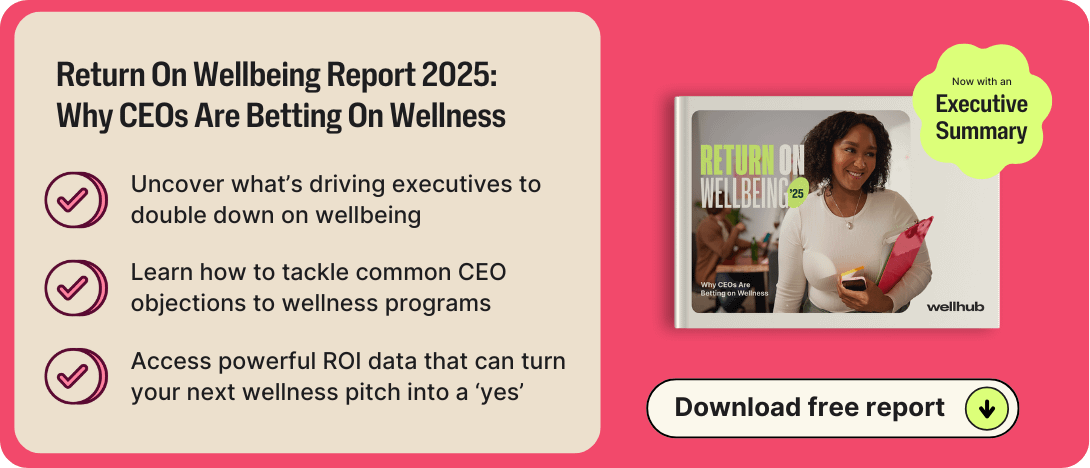
Challenge 3: “Is this just fluff? We have bigger issues – and some folks are cynical.”
The Concern: Skepticism can come from all sides. Employees might think, “A wellness program? Great — but will it fix my workload or my paycheck?” If the work environment already has high stress, understaffing, or weak benefits, a wellness launch can feel like window dressing. And public skepticism about corporate wellness programs doesn’t help.
Why it Happens: When bigger cultural or structural problems go unaddressed, wellness can feel hollow. Suggesting meditation while people work 12-hour days sends the wrong message. Privacy fears, bad past experiences, or “checkbox” programs also erode trust.
How to Overcome It: Start with honesty and context. Acknowledge that a wellness program isn’t a silver bullet — and commit to improving work conditions alongside it. This means addressing root causes like unrealistic deadlines, after-hours expectations, and lack of recovery time. Include manager training on preventing burnout and supporting work-life balance.
Be transparent: “A meditation app won’t solve everything — but it’s one tool, alongside changes we’re making to reduce stress at the source.” Validating employees’ reality builds credibility.
Address privacy concerns head-on. Make it clear that personal health data is confidential, reported only in aggregate, and participation is voluntary.
Let proof replace doubt. Share real success stories as they happen — from better work-life balance to improved morale. Peer influence is powerful; a skeptical manager may reconsider after hearing a colleague’s team is thriving because they embraced wellness resources.
If someone says, “We have bigger issues,” agree — and explain how wellness is part of the solution. Link it to organizational priorities like customer service, innovation, or safety. Educate skeptics on the connection between wellbeing and performance: healthy, engaged employees drive results.
Bottom line: Overcome cynicism with empathy, transparency, and evidence. Show that wellness isn’t just yoga mats and fruit bowls — it’s a strategic, genuine commitment to fixing real pain points. With consistent action and visible leadership support, even the cynics can become advocates.
Examples of Successful Workplace Wellness Plans
Heineken & Wellhub
Heineken is a world leader in alcoholic beverages, With operations in more than 70 countries, Heineken faced a familiar challenge for growing organizations: How do you deliver consistent, meaningful wellness support to a workforce that’s as diverse as it is distributed?
Their solution was a flexible, accessible wellness plan powered by Wellhub. This approach gives employees from corporate offices to production lines access to activities that support physical health, meditation, and nutrition. That flexibility ensures every team member can choose the wellness resources that work for their schedule and goals.
AstraZeneca & Wellhub
AstraZeneca operates in more than 100 countries and employs over 70,000 people. When they set out to strengthen workforce wellbeing, their goal was clear: simplify the process of offering a truly people-centered benefit.
What stood out about Wellhub was its ability to provide an all-in-one solution for physical, mental, and nutritional health — and to deliver it in ways that work for a hybrid workforce. Employees can choose from in-person, online, and on-demand options. That flexibility drives adoption, with six in 10 eligible employees actively engaging with the wellness offerings.
Aflac & Wellhub
When Aflac set out to transform employee health, they wanted to do so alongside building a culture of sustainable wellbeing. In 2022, the company launched Wellhub and saw 15% of employees enroll on day one. By 2023, Aflac rolled out Wellhub+ to fully cover the Starter plan for every employee, doubling participation.
The shift came as the company moved away from spending nearly $25 million a year on GLP-1 medications for 1,000 employees, redirecting investment into a platform that supports physical, mental, nutritional, and emotional health. Today, 45% of employees actively use Wellhub, with leadership championing the program in town halls, wellness challenges, and across day-to-day work life.
“There’s no dollar amount greater than saving someone’s life,” says Tricia Griggs, Manager of Wellness and Safety at Aflac. “We wanted to be sure that platform could support us. And it did.”
🦆Aflac case study: From Medications to Movement: How Aflac Sparked A Culture Shift with Wellhub
Turn Workplace Wellness into a Competitive Edge
Burnout, sick days, high costs, and lost talent drag companies down. A powerful wellness program flips the script — helping employees thrive physically, emotionally, financially, and socially.
The payoff is big: organizations with strong programs cut healthcare costs by up to 35% and turnover by as much as 40%. Healthy, engaged teams work smarter, stay longer, and drive better results.
Speak with a Wellhub Wellbeing Specialist to build a program that energizes your people and boosts your bottom line.

Company healthcare costs drop by up to 35% with Wellhub*
See how we can help you reduce your healthcare spending.
Category
Share

The Wellhub Editorial Team empowers HR leaders to support worker wellbeing. Our original research, trend analyses, and helpful how-tos provide the tools they need to improve workforce wellness in today's fast-shifting professional landscape.
Subscribe
Our weekly newsletter is your source of education and inspiration to help you create a corporate wellness program that actually matters.
Subscribe
Our weekly newsletter is your source of education and inspiration to help you create a corporate wellness program that actually matters.
You May Also Like

Corporate Wellness Trends HR Must Know for 2026 | Wellhub
See the top 2026 wellness trends shaping performance, retention, and culture—plus how HR can build a unified, ROI-driven wellbeing strategy.

Wellness Points Programs: Boost Employee Health & Engagement | Wellhub
Turn your workplace wellness strategy around with a points program that rewards healthy behavior with perks, from extra time off to gift cards.

Employee Financial Wellness Programs: Ultimate HR Guide | Wellhub
Create an effective financial wellness program that supports your employees in their financial needs, boosting productivity and retention.